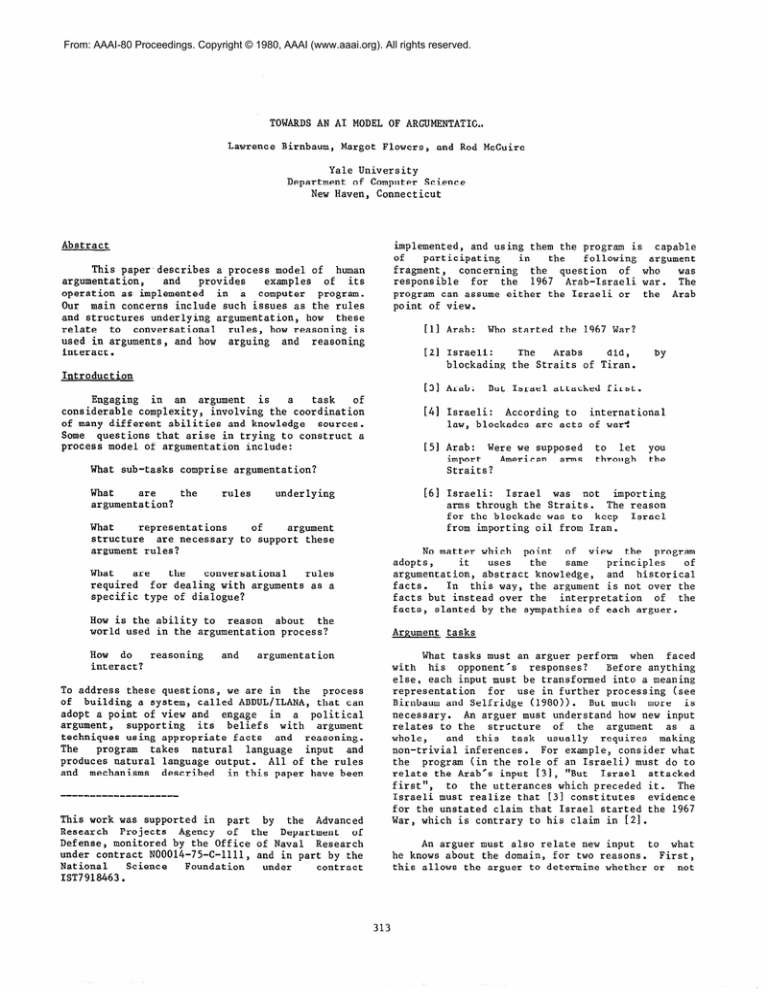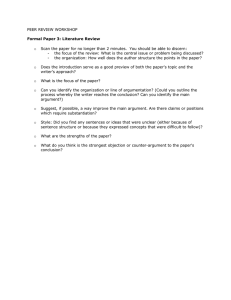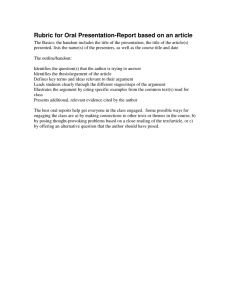
From: AAAI-80 Proceedings. Copyright © 1980, AAAI (www.aaai.org). All rights reserved.
TOWARDS
Lawrence
AN AI MODEL
Birnbaum,
Margot
OF ARGUMENTATIGA.
Flowers,
and Rod McGuire
Yale University
Department of Computer Science
New Haven, Connecticut
Abstract
implemented,
and using them the program is capable
of
participating
in
the
following
argument
fragment,
concerning
was
the
question
of who
responsible
for
the
1967 Arab-Israeli
war.
The
program can assume either the Israeli or
the Arab
point of view.
This paper describes a process model of human
and
provides
its
argumentation,
examples
of
program.
operation as implemented
in a computer
Our main concerns include such issues as the rules
and structures underlying argumentation,
how
these
rules, how reasoning is
relate
to conversational
reasoning
used in arguments, and how
arguing
and
interact.
[ll
Arab:
Who
[21 Israeli:
blockading
started
the 1967 War?
Arabs
The
did,
the Straits of Tiran.
by
Introduction
[31 Arab:
task
of
Engaging
in an argument
is
a
involving the coordination
considerable
complexity,
of many different abilities and knowledge
sources.
Some
questions that arise in trying to construct a
process model of argumentation
include:
What
sub-tasks
What
are
argumentation
comprise
the
[51 Arab:
Were we supposed
American
arms
import
Straits?
of
argument
to support these
How
do
interact?
reasoning
and
to let
through
you
the
No matter which
point
of view
the
program
it
same
principles
of
adopts,
uses
the
and
historical
argumentation,
abstract knowledge,
facts.
In this way, the argument is not over the
interpretation
of
the
facts but instead over the
facts, slanted by the sympathies of each arguer.
What
are
the
conversational
rules
required
for dealing with arguments as a
specific type of dialogue?
How is the ability to reason
world used in the argumentation
first.
[6l Israeli:
importing
Israel
was
not
The reason
arms through the Straits.
for the blockade was to keep
Israel
from importing oil from Iran.
underlying
?
What
representations
structure
are necessary
argument rules?
attacked
international
[41 Israeli:
According to
law, blockades are acts of war<
argumentation?
rules
But Israel
the
about
process?
Arpument
argumentation
tasks
What tasks must an arguer perform
when
faced
Before anything
with
his
opponent's
responses?
into a meaning
else, each input must be transformed
representation
for
use in further processing
(see
Birnbaum and Selfridge (1980)).
But much
more
is
necessary.
An arguer must understand how new input
argument
as a
structure
of the
relates to the
requires
making
and
this
task
usually
whole,
For example, consider what
non-trivial
inferences.
the program (in the role of an Israeli) must do to
relate the Arab's input [31, "But
Israel
attacked
to the utterances which preceded it. The
first",
evidence
Israeli must realize that [31 constitutes
for the unstated claim that Israel started the 1967
War, which is contrary to his claim in [21.
To address these questions, we are in the
process
of building a system, called ABDUL/ILANA,
that can
adopt a point of view and
engage
in a political
argument,
supporting
its beliefs
with
argument
reasoning.
techniques using appropriate
facts
and
The
program
takes
natural
language
input
and
produces natural language output.
All of the rules
and mechanisms
described
in this paper have been
This work was supported in part
by
the Advanced
Research
Projects
Agency
of
the Department
of
Defense, monitored by the Office of Naval
Research
under contract N00014-75-C-1111,
and in part by the
Science
National
Foundation
under
contract
IST7918463.
An arguer must also relate new input
to what
he knows about the domain, for two reasons.
First,
this allows the arguer to determine whether or not
313
he believes
that
some
claim put to him is true.
Second, in doing
this
he
can uncover
relevant
which
may
be useful
in forming
a
information
response.
knowledge of how to look through this network for a
point
which
can
be
attacked or defended.
As an
the
example of the use of such rules, consider how
generates
a
program
(operating
as the Arab)
response to input 141:
Once the understanding
sub-tasks sketched
out
above have been accomplished,
an arguer must decide
how to respond.
This involves
several
levels
of
make
large-scale
must
First,
he
decision.
to attack
his
strategic choices, such as whether
defend
his
own,
change
the
claims,
opponent's
Second, he must
determine
subject, and so forth.
should be taken up, and how evidence
which
points
can be
provided
for
or against
those
points.
use
his
knowledge and reasoning
Third,
he must
ability in order to actually produce such evidence.
This
final
step
ends with
the generation of a
response in natural language (see McGuire (1980)).
ArPument
structures
international
[41 Israeli:
According to
law, blockades are acts of war.
This point stands in a support
relation
previous Israeli claims of utterance
[21:
[2al The Arabs
A
I
I
support
and rules
--
did,
The
Arabs
the Straits of Tiran.
requires not only understanding
propositions:
[2al The Arabs
started
[2bl The Arab blockade
the
two
I
support
I
141 Blockades
separate
but also realizing that the second proposition
[2bI
the
first
support
relation
to
stands
in
a
are
The
argument
relations
proposition
112al.
such
structures,
including
themselves
complex
rules
enabled
the
f information as which inference
(See de Kleer et
the
relation,
establishment
of
a discussion
of
al.
(1977) and Doyle (1979) for
related techniques.)
argument
One motivation
for
having
these
their
local "geometry" can be
relations
is that
in determining
how
to
tactics
used by argument
that
These
are
rules
input.
respond
to the
to how
to go
about
describe
the options
as
attacking
or defending a proposition based on the
For
part.
argument relations in which
it takes
such rule coordinates
the three ways
one
example,
to attack a simple support relationship:
point
(b) Attack
the supporting
I---[3al
The Israelis
started the war.
A
I
support
I
[3bl The Israeli attack
led to the war.
are acts of war.
Once the program
has
decided
to follow
an
attack
strategy,
it needs to find a weak point in
In this
case
a search
the opponent's argument.
rule
traversing
suggests
up the support links in
the most
recent
input.
the graph, starting with
The
first
item
considered
is 141, the Israeli's
However this
claim that blockades are acts of war.
was
already
checked
during
the
proposition
one
of. the
understanding
phase and found
to be
program's
beliefs.
Thus,
it
is not
a good
link
Traversing the support
candidate for attack.
the Arab
leads
to
[2bl,
the
proposition
that
too was
However,
this
blockade led to the war.
verified
during understanding.
Following one more
link leads
to
[2al,
the
claim
that
the Arabs
started the war, which the Arab does I&
believe to
be true.
Hence,
this
is a good
candidate
for
attack.
led to the war.
the main
the war.
by
the war.
(a> Attack
the
I
attack
I
[2bl The Arab blockade
led to the war.
6
There are basically two ways that propositions
One point
in an argument can relate to each other.
case
can be evidence for another point,
in which
the argument relationship
is one of support, or it
the
case
can challenge the other point, in which
Thus, for example,
is one of attack.
relationship
the ultimate analysis of the Israeli's statement:
[21 Israeli:
blockading
started
A
to
the
three
tactics
Now the program considers
for
attacking
this
proposition's
simple support
relation.
the main
point,
Tactic (a>, attacking
has already been used once, as can be determined by
the
argument
Tactic
inspecting
graph.
(b),
attacking
the evidence, can't be used in this case
since the evidence has already been rejected
as a
candidate
for
attack by the argument graph search
rule.
This leaves tactic cc>, attacking the
claim
that
the evidence is adequate support for the main
point.
directly;
evidence;
Having decided to attack this support relation
between
proposition
that the Arabs started
[2al,
the war, and [2bl, that the Arab
blockade
led
to
the war,
the
program
now attempts to do that by
inferring a justification
for the blockade,
using
its abstract knowledge of blockades and its factual
This
knowledge of U.S.
military aid
to Israel.
justification
is ultimately generated as:
(c) Attack the claim
that
the
evidence
gives support for the main point.
history
of
entire
The representation
of the
of propositions
the
argument,
as
a network
arpument
connected by argument relations, forms an
embody
Argument
graph.
graph
-search
-rules
314
151 Arab:
Were we supposed
import
American
arms
Straits?
to
let
through
you
the
subsequent
&
memory
&I arguments
We
have
been
particularly
concerned
with
investigating
how
reasoning
and memory
search
interact with the argument process.
Reasoning
in
an
argument
is
not
simply
blind
inference:
requirements
imposed
by
the
structure
of
the
argument
constrain
when and how inferences should
be made.
For example, consider
how
the program,
when
adopting
the Israeli point of view, responds
to question [ll:
El1 Arab:
[2al
Who
Israeli:
started
[2b] Israeli:
. ..
Straits of Tiran.
Thus
a prime
method
for
finding
possible
responses
is simply to make use of facts that have
been
noticed
by
prior
inferential
memory
processing.
This mechanism also enables the system
to deny false presuppositions
without the necessity
for
a special rule.
This is because in the course
of relating
input
which
contains
a
false
presupposition
to
long-term
memory,
the program
would discover
the
falsehood
-and
often
the
reason why it's false.
Having this in hand, it can
then be used in a rebuttal.
the 1967 War?
The Arabs
by
did,
blockading
Conclusion
the
Engaging
in an argument
requires
several
distinct
kinds
of knowledge:
knowledge
of the
domain, knowledge of how to reason,
and
knowledge
of how to argue.
The proper coordination
of these
disparate knowledge sources
can have
a mutually
beneficial
effect
in
reducing
undirected
processing.
This
kind
of
result
would
be
impossible
in a simplistic model based on strictly
separate processing stages.
In this case,
the
generation
of
[2al does
not
require
the use
of argument
rules
or episodic
memory retrieval.
Instead it is derived by use
of
a "gut reaction" rule that always assigns blame for
"bad" events to some other
participant.
However,
as
soon
as such a claim is put forth in a serious
argument, it must be supported.
The
support
[2bl
is
then
produced
by
a more
complex
use
of
inferential memory, activated only in response
to
the argument goal of providing support.
References
Birnbaum, L., and Selfridge, M.
1980.
Conceptual
Analysis
of Natural Language, in R.
Schank and C.
Riesbeck,
eds.,
Inside
Computer
Understanding,
Lawrence Erlbaum Associates, Hillsdale, N.J.
Conversely, reasoning
and memory
guide
the
argument
process
by
discovering
information that
affects
subsequent
argument
choices.
In
particular,
good
rebuttals
may often be found in
the course of understanding
the
input.
Consider
how the program (in the role of the Arab) processes
utterance
[21:
[21
Israeli:
blockading
The
Arabs
did,
the Straits of Tiran.
can.
The program checks
the plausibility
of
121
above by employing CT search backwards in time from
the
start
of the war,
looking
for
the
Arab
blockade.
However, in the course of this search it
naturally discovers the initial event
of the war
episode, the Israeli attack, which is then noted as
.
a possible cause
of the war.
Search
continues
until
the Arab
blockade is verified.
Then, when
the time comes to respond to input [21, the Israeli
attack
has
already
been
found
as a possible
rebuttal,
so that
explicit
no
search
need
be
initiated.
An interesting point about question [51 is that
it
has
the
form
of
the standard argument gambit of
asking one's
opponent
to support
or
justify
a
position.
What
makes
the question rhetorical is
the assumption that, in this
case,
there
is no
justification
for
demanding that arms importation
be allowed,
Reasoning
event
de Kleer, J., Doyle, J., Steele, G.,
and
Sussman,
G.
1977.
AMORD:
Explicit Control of Reasoning,
in Proc.
ACM SYUIP.
on Artificial Intellipence and
Programming
Languages,Rochester,
N.Y.
by
Doyle,
J.
1979.
A Truth
Artificial
Intelligence,
vol.
To understand this input, the Arab must
relate
it
to what he knows in order to verify its truth, and
perhaps
more
importantly,
uncover
his
relevant
knowledge.
How
does the program verify the claim
that the Arab blockade led to the war?
Maintenance
12, no.
3.
McGuire, R.
1980.
Political Primaries
and
of Pain,
unpublished
ms., Yale University,
of Computer Science, New Haven, CT.
System,
Words
Dept.
Schank,
R.
1979.
Reminding
and
Memory
Organization:
An
Introduction
to MOPS, Research
Report
no.
170,
Yale
University,
Dept.
of.
Computer Science, New Haven, CT.
Access to historical events in memory
depends
upon
their
organization
into
temporally ordered
chains
of related
events
(see
Schank
(1979)).
These
chains
are
searched
by
a process called
causal-temporal
(CT) search.
CT
search
contains
the
system's
knowledge
about
relations
between
causality and temporal
ordering.
Such
knowledge
includes,
for
example, the rule that any event up
to and including the first
event
of an
episodic
sequence
can be
a cause of that sequence, but no
315







